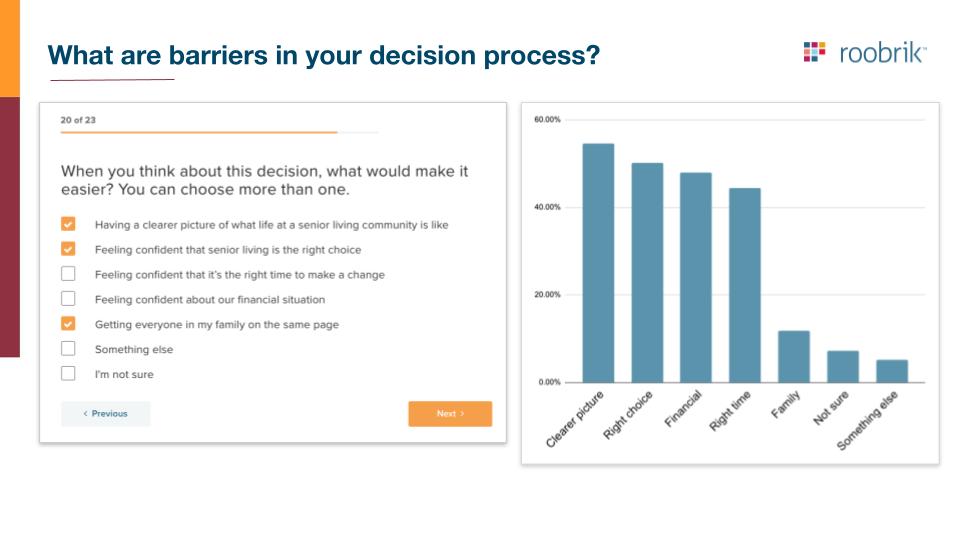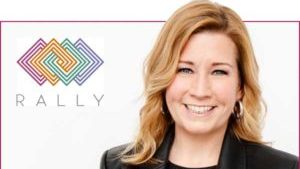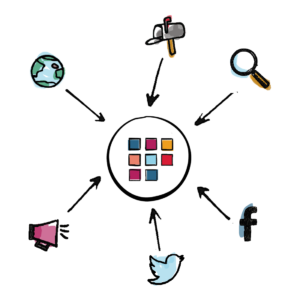The New “Digital Normal”
 Guest post by Robert Grammatica
Guest post by Robert Grammatica
ROBERT GRAMMATICA IS THE CEO & FOUNDER OF LONGEVITY POINT ADVISORS, LLC, A MARKETING CONSULTANCY FOCUSED ON SENIOR LIVING AND HEALTHCARE. A 25+ YEAR MARKETING VETERAN, GRAMMATICA WAS FORMERLY THE CMO OF A PLACE FOR MOM AND IS CURRENTLY A PAID CONSULTANT FOR ROOBRIK.
There are no prospects more important than the ones that are on your website right now. Despite your competitors, COVID, political turmoil, and dozens of reasons to say “not now,” they are on your website, thinking about the life-changing decision to live with you. And their expectations have changed.
“Quarantine culture” has accelerated the uptake of all things digital by families and prospective residents. From weekly multi-generational ZOOM chats to online learning and video consumption, demand for virtual experiences is on the rise, even with older adults.*
With senior living search volume and site traffic returning to pre-COVID levels, now is the time to step up digital marketing spend and innovate to meet the demand. Competition for new leads is becoming more fierce, and digital spend — led by national operators and online lead aggregators — will skyrocket. Operators need to build a stronger digital foundation that maximizes every lead conversion opportunity possible, that treats every website visitor like gold.
The following tips detail how to make the most of your marketing spend to capitalize on pent-up demand in the new “digital normal.”
1: Focus on the most productive digital channels first.
Think of your website as the first “secret tour” families take of your community. How do you maximize its pull and keep visitors engaged?
1. Go beyond Google My Business tips to ensure you’re not only at the top of the local pack, but that you have page content that ranks high on valuable search terms. For example, many consumers still use “nursing homes” when they mean IL. Don’t shy away from content related to SNFs; instead educate families about the distinction.
2. SEO traffic without conversion is, well, useless. Go beyond the obligatory CTAs of call, schedule a tour, or download a brochure. On-page video content, tools, and downloadable content all help increase lead capture performance. Ongoing marketing automation efforts will help ensure each component is driving leads.
3. Make sure that PPC dollars are focused on high-value keywords that are hyperlocal to each community’s location, preferably geofencing within a 15-20 mile radius. Instead of focusing on lead volume, track and optimize your spend-to-move-in revenue.
4. Paid social/Facebook is great for CCRC’s targeting younger prospects, but… it can be a real challenge to monetize for AL providers targeting adult caregivers. The audience is there, but most are not in a buying moment. Retargeting and marketing automation after initial exposure is essential for making Facebook work.
5. Prepare for the cookie-less future. As third-party cookies are phased out over the next two years and ad targeting becomes harder, marketers need to future-proof their business by collecting first party data about visitors — page views, downloads, and a variety of CTAs along the visitor’s journey.
2: Capture leads and build engagement with qualified families already on your website.
Challenge: The vast majority of senior living websites allow 98%+ of site visitors to bounce without ever capturing their names. Most families are just not ready to call or click the ‘make an appointment’ or ‘schedule a tour’ button.
Why: Given no other way to engage or get answers, families continue the search online. Many get scooped up by your competitors, lead aggregators, lead gen affiliates, or publishers. Unfortunately, that means that when visitors are ready to engage, communities may end up re-acquiring them through other media or, worse, paying a referral agency for a lead they should already own.
Solution: Communities need to offer compelling content and tools onsite that engage visitors and meet their needs at each stage of the decision journey, before they’re ready to talk with a rep or tour.
One example is Roobrik. It’s a highly effective self-assessment tool that communities can get up and running quickly to take advantage of pent-up site traffic A simple widget added to a community’s site immediately increases lead volume by helping visitors who were previously unsure about talking with a community advisor get “unstuck” and move forward. It provides a high-value service to families without overtly selling.
3: Embrace virtual experiences & patch your leaky pipeline with speed to lead.
Opportunity: Many communities are building and refining new capabilities in virtual tours, webinars, and video walkthroughs. Originally designed to bridge the gap until communities can welcome families in-person, it’s becoming clear that the consumer demand for remote tours, video chat, email, and text communication is here to stay
Communities that are adept at understanding and balancing the website experience, virtual tours, and in-person walk-throughs will have an expanded opportunity to engage, prequalify, and capture leads even earlier.
Opportunity: Despite the explosion of digital communication, it’s remarkable how many leads are lost due to the lack of immediate follow-up. The entire online lead referral business is built on speed-to-lead follow-up and rapid lead referral. Why? Quite simply, because it consistently produces a tangible advantage.
While most communities can’t spend the resources to always be the first to the lead, every improvement in follow-up helps. Consider hiring a dedicated tech-savvy admin to do it across communities or, if budget permits, hire an external service to respond with a friendly message and pre-qualify leads before they’re lost. These added expenses can pay for themselves many times over in faster closes.
*According to Satya Nadella, CEO of Microsoft, digital adoption has accelerated two years in two months during the pandemic.





